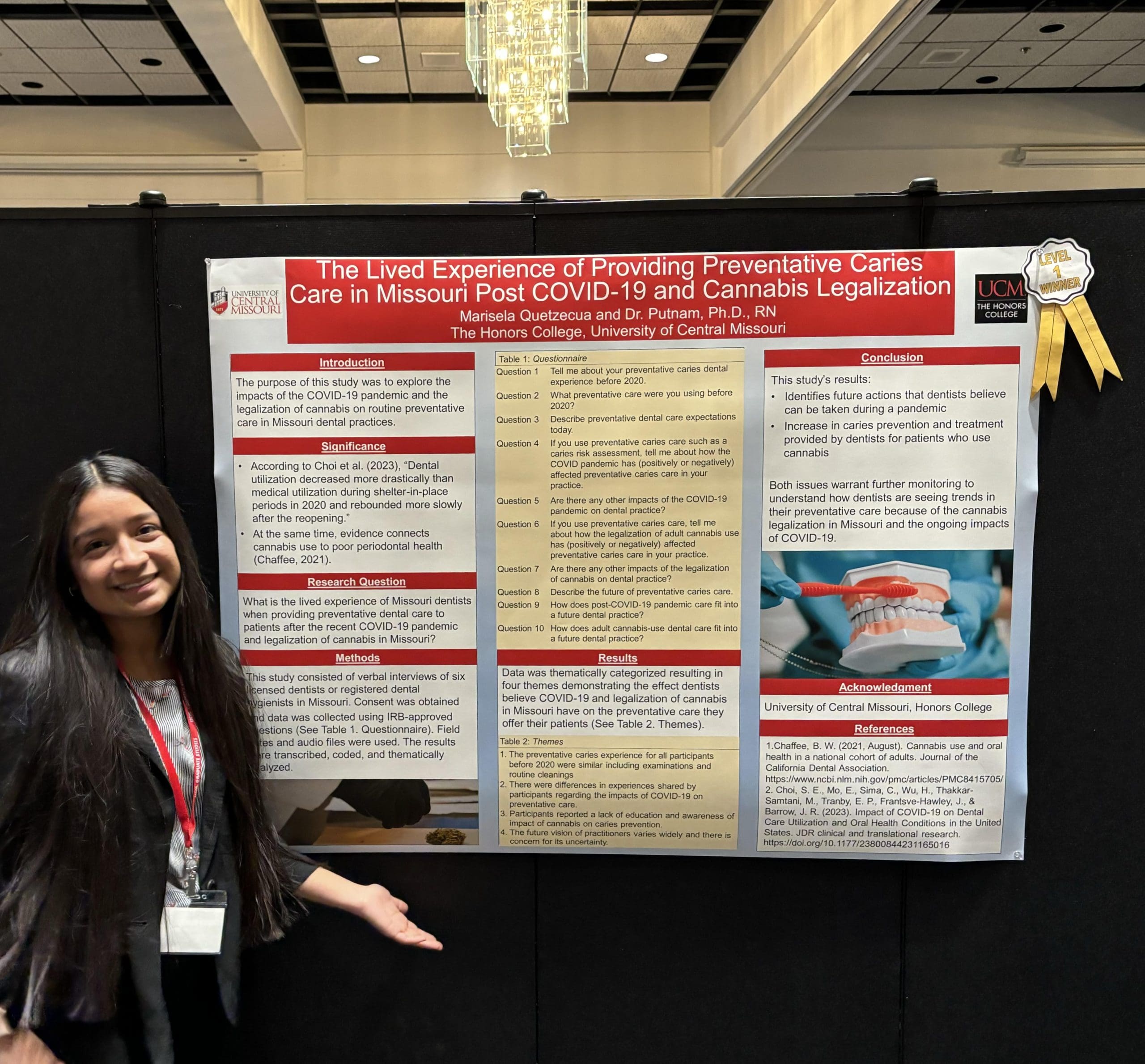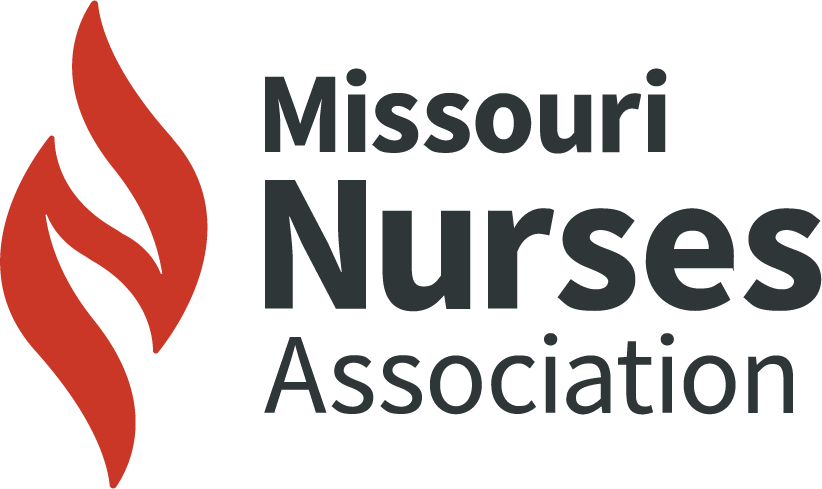NURSES IN MISSOURI must be able to assess a client’s ability to perform activities of daily living including preventative oral care (Registered Nursing.Org, 2024 ). The oral care plan should meet oral care standards and educate about various methods, safety measures, and the use of assistive devices to facilitate self-care hygiene.
For Missouri nurses to stay current in their practice, it is important to understand how both cannabis legalization and COVID-19 have affected preventative oral care. This qualitative study aimed to explore the impact that recent events such as the COVID-19 pandemic and the legalization of cannabis may be having on preventative dental hygiene in Missouri.
BACKGROUND
Preventative dental practices commonly include caries risk assessments. Different types of caries risk assessments are available. A caries risk assessment helps dentists plan an intervention depending on the responses. For example, if a patient is not using fluoride toothpaste, then they may be more prone to get caries. This allows the dentist or dental hygienist to recommend and educate the patient on the importance of using fluoride toothpaste.
Joseph et al. (2011) state that newly graduated dentists use a caries risk assessment because they used it in their dental school education. This is a method schools use to educate dental students on the importance of setting individual goals for patients. Caries risk assessments are also used in improving dental access for at-risk infants and toddlers (Long et al., 2012).
According to Choi et al. (2024), dental utilization decreased faster than medical during shelter-in-place (2020) and rebounded more slowly later. Choi explains that during COVID-19, there was a greater demand for oral surgery and teledentistry and less demand for preventative services. As a result of COVID-19 delayed treatment, patients are now receiving more complex dental treatment.
The American Dental Association (n.d.) reports that cannabis smoking can be associated with an increased risk of mouth and neck cancers. Smoking cannabis can cause xerostomia which can contribute to other oral health conditions. Routine cannabis users have a significantly higher number of caries than nonusers. According to Chaffee (2021), the evidence connects cannabis use to poor oral health.
What are the long-term nursing implications of poor preventative oral care? Missouri skilled nursing facility residents (N=253) reported that 49% of residents rely on staff to clean their mouth, many have no Medicare dental coverage, and Medicaid covers a limited number of dental services (The Oral Health of Adults, 2022). People with less than 20 teeth have problems eating healthy food. 73% of residents reported severe tooth loss and 38% had no natural teeth. Decay is untreated in 40% and gum disease in 29% causing pain and life-threatening infections.
Research has previously looked at pre and post-COVID-19 separately from cannabis. However, it is critical to see how the real-life cannabis legalization and the concurrent COVID-19 pandemic affected patients and their preventative oral care. Hence, the research question: What is the lived experience of Missouri dentists when providing preventative dental care to patients after the recent COVID pandemic and legalization of cannabis in Missouri?
METHODOLOGY
As an exploratory study, a qualitative phenomenological research design was used. Study participants included six currently practicing dentists or dental hygienists in Missouri. These dentists were interviewed using an IRB-approved questionnaire (See Table 1. Lived Experience Dental Caries Prevention Questionnaire). Field notes and audio files were used. The results were transcribed, coded, and thematically analyzed describing the lived experience that dentists report regarding post-COVID-19 and the legalization of cannabis has had on their patients.
The interview using the questionnaire took approximately 20 minutes per participant. Consent for the study was obtained. The interviews were held in person, via video or phone call. After conducting the interviews, transcripts were made. This allowed further analysis to discover the preventative measures being implemented to reduce caries and the impact COVID and legalized cannabis have had. (Table 1.)
TABLE 1: Lived Experience Dental Caries Prevention Questionnaire
RESULTS
Data were categorized into four overarching themes. Those themes were (1) caries care prevention experience before 2020 was similar including examinations and routine cleanings, (2) there were differences in experiences shared by participants regarding the impacts of COVID-19 on preventative care, (3) the lack of education and awareness of the impact of cannabis on caries prevention, and (4) the future vision of practitioners varies widely and there is a concern for its uncertainty.
Theme One: The preventative caries experience for all participants before 2020 was similar including examinations and routine cleanings.
Interview data reflects that the caries care prevention experience before 2020 was similar. This theme obtained the greatest frequency of codes. Each participant shared their clinical experiences regarding caries prevention care before 2020.
One participant said, “When patients come in for an examination, I do a complete examination and try to promote prophylaxis and all preventative treatments which is twice a year” (Participant #1). Another commented, “Before COVID, I had the ability to have more face-to-face communication” (Participant #3). While a third shared, “We have had protocols that were more than what COVID-19 expected” (Participant #2).
The participants shared that preventative care included fluoride treatments, sealants, and oral hygiene instructions. One participant said, “Everything under the umbrella of preventive care sealants but also prescription fluoride as indicated for higher risk individuals, silver diamine fluoride on early incipient lesions” (Participant #4).
Theme Two: There were differences in experiences shared by participants regarding the impacts of COVID-19 on preventative care.
Participants reported that preventative expectations are the same, however, it is more difficult to reach individuals who struggle to go to the dentist because many have not come back since COVID-19. One participant said, “I feel pretty similar in the tools available such as fluoride and the IM paste” (Participant #4). Another commented, “Patients would disappear and it would take a lot of effort for them to come back.” (Participant #3).
There were inconsistencies in the impacts reported for COVID-19 on preventative care including not a lot of difference, a negative result in prevention due to COVID-19 delayed oral care, increased difficulty communicating with patients due to PPE, and more patients with urgent dental needs including fractured teeth from intubation One participant said, “I’d say I have not really noticed a difference “ (Participant #6). Another reported, “I feel this created a lot of separation between myself and the patient” (Participant #3). A third commented, “There was such a long period of time where we needed to triage what patients were being seen and prioritized basically you know our urgent situation” (Participant #4).
The impacts of COVID-19 on dental practice were described as serious including temporary clinic closures and increased staffing costs. One participant said, “We shut down for 10 days so there were periods of time that we were not open because we had patients that actually tested positive” (Participant # 1). Another participant said, “ Staff costs are a lot more trying to get staff is totally different” (Participant #5).
Theme Three: Participants reported a lack of education and awareness of the impact of cannabis on caries prevention.
Participants reported that it is still too early to tell the impact of cannabis legalization on dental practice. Most participants report having no direct experience with cannabis users, having only read about it. One participant said, “I have no experience with that” (Participant #5). Another commented, “ I think that it will lead to more oral health issues just because what we do know about cannabis is that it causes dry mouth and dry mouth can lead to a tremendous amount of caries lesions” (Participant #3). One mentioned, “ I don’t feel like I have noticed too significant impacts. I think it is too early to say “ (Participant #4). Many participants reported feeling uneducated about this subject and were unaware of the impacts of the legalization of cannabis on their dental practice. One participant commented, “I’ll be honest that is not something I have read up on.” (Participant #4). Another said, “What I have read a lot on forms is this is mainly for oral surgeons. One problem they are having is that it is more difficult to put them to sleep and it is also potentially more difficult to numb” (Participant #3).
Theme Four: The future vision of practitioners varies widely and there is concern for its uncertainty.
Respondents believe there will be advances in technology such as increased electric toothbrushes, community interventions, ongoing cavity prevention as well as an increase in reimbursement. One participant said, “A lot more technology that can detect caries” (Participant #5). Another said, “ caries getting addressed before it has reached a severe state” (Participant #4). One explained, “I have seen more who are interested in using electric toothbrushes” (Participant #2).
Dentists thought they would be able to use what they learned from COVID-19 in practice including personal protection, architectural building designs, and prevention of cross-contamination. One participant said, “I asked my front desk if they wanted me to take that down and they said no because people are always sneezing and coughing like we actually like that barrier.” (Participant #5). Another commented, “People being able to afford private practices because of the cost of staff until all of that goes back to normal” (Participant #6).
According to the participants, the future dental care visions for cannabis users are uncertain and vary widely. There is a concern about the lack of dental research on medicinal cannabis. One participant said, “ It will be interesting to have more studies on positive or negative use of cannabis use” (Participant #4). Another said, “ I do not find a major effect from cannabis as it helps some patients relax.” (Participant #2).
DISCUSSION
Nurses can promote good oral care for their patients with the CDC Oral Care Guidelines (2024) found in Table 2.
TABLE 2: CDC Oral Care Guidelines
- Nurses can promote preventative oral care with the CDC Oral Care Guidelines.
- Drink fluoridated water and brush with fluoride toothpaste.
- Brush teeth thoroughly twice a day and floss daily between the teeth to remove dental plaque. When acting as a caregiver, help older individuals brush and floss their teeth if unable to perform these activities independently.
- Visit a dentist at least once a year, even with dentures or no natural teeth.
- Avoid tobacco products, quit smoking, and limit alcoholic drinks.
- Work to maintain control of diabetes decreasing risk for complications including gum disease. Treating gum disease may help lower blood sugar levels.
- If medication causes dry mouth, ask for a different medication that may not cause this condition. If dry mouth cannot be avoided, drink plenty of water, chew sugarless gum, and avoid tobacco products and alcohol.
- Report sudden changes in taste and smell.
To reduce caries, fluoride, sealants, and Xylitol (a five-carbon sugar alcohol that inhibits bacterial metabolism and increases salivary flow, reducing the transfer of bacteria from mother to child), and behavior modification approaches may be used (Macri, 2018). In this study, participants described using the same prophylaxis/preventative treatment protocols in both post-COVID-19 and post-legalization of cannabis in Missouri. Participant #1 states promoting prophylaxis and twice-yearly preventative treatment. However, Participant #3 commented before they could have more face-to-face communication. In addition, Participant #4 felt there was a more doctor and patient relationship. The Missouri Department of Health and Senior Services recommends that nurses advocate for expanding programs that provide educational and preventive dental services, developing programs that provide corrective and emergency dental services, providing enhanced training to staff about the importance of daily oral hygiene services, creating a referral system for safety-net dental clinics for residents with urgent dental needs, and consider the use of silver diamine fluoride treatment by public health hygienists for patients with transportation barriers (2022).
According to Brian & Weintraub (2020), populations affected by COVID-19 are also at higher risk for oral diseases. They explained that COVID-19 closed and reduced hours of dental practices providing routine care and prevention. Emergency and urgent services were not affected in the same way. In this study, Participant #1 mentioned they had to shut down for 10 days and Participant #3 stated that COVID-19 created a tremendous backlog. Participant #4 also said that there was a period when they needed to triage more urgent appointments.
The University of Illinois (2022) states that cannabis can have both positive and negative effects on oral health in its many forms such as marijuana, hash, hash oil, and concentrates. Positive effects of cannabis include controlled hunger and appetite, pain relief, reduction of asthma attacks, reduced glaucoma, relaxation, and euphoria and negative effects of cannabis include disorientation, weakened perception, possible increased risk of caries and periodontal disease, and dry mouth (2022). Similarly, Participant #3 mentioned that he hasn’t really noticed a change but has read that it causes dry mouth which can lead to a tremendous amount of caries lesions and an increase in appetite. Participant #4 said it is too early to say. In the same way, other participants mentioned that they had no experience with cannabis users. Nurses are developing new evidence-based cannabis assessment tools such as the Cannabis Use and Behaviors Assessment Tool for pre-anesthesia evaluation (Sladkey, et al., 2024), and these innovations will likely be modified to have a role in oral care for cannabis users in the future.
According to Dye et al. (2022), new technologies and advances in materials and practice will not alone improve oral health. Dye et al. (2022) state that addressing challenges affecting access to care is a critical role for healthcare professionals. The three strategies to expand dental coverage and improve access to care are (1) to make dental care services an essential benefit for private and public insurance, (2) to incorporate dental or oral health care services demand into workforce planning, and (3) to increase the integration of oral and medical care delivery.
In contrast in our study, none of the participants mentioned they believed the future would involve providing more access to care; however, Participant #3 stated that the state increased the rate of reimbursement of Medicare and in the future, there will be more availability to low-income patients. Participant #5 said there would be more technology that can detect caries. Other participants like Participant #1 commented that protocols to prevent caries would remain the same.
This qualitative study has several limitations including a small convenience sample, reducing the transferability and dependability of the results. This study was challenged with data collection and analysis that was time-consuming and resource-intensive (Business Research Methodology, n.d). Lastly, the study focused on what is or has been recent. It is not predictive, making it hard for policymakers to infer what actions should occur in the future. Because of this, some policymakers may give qualitative studies low credibility.
CONCLUSION
The results of this study demonstrate that before 2020, the preventative caries experience (examinations and routine cleanings) for all participants was similar. The preventative care reported included fluoride treatments, sealants, and oral hygiene instructions. The participants reported that preventative expectations have returned to the same as before, however, participants reported that it is more difficult to reach individuals who struggle to go to the dentist. Many have not come back since COVID-19.
There were differences in experiences shared by participants regarding the impacts of COVID-19 delaying preventative care. Participants reported increased difficulty communicating with patients while using PPE. Some participants reported more patients with urgent COVID-related dental needs such as fractured teeth from intubation. The impacts of COVID-19 on dental practice were described as serious including temporary clinic closures and increased staffing costs.
Participants reported that it is still too early to tell the impact of cannabis legalization on dental practice. Most participants report having no direct experience with cannabis users. Many participants reported feeling uneducated about cannabis and dental care. Some participants said they were unaware of any impacts of the legalization of cannabis on their dental practice.
Respondents believe there will be advances in technology such as increased electric toothbrushes, community interventions, ongoing cavity prevention, and an increase in reimbursement. Dentists will be able to use what they learned from COVID-19 in practice including personal protection, architectural building designs, and prevention of cross-contamination. Future care visions for cannabis users are uncertain and vary widely. There is a concern about the lack of dental research on medicinal cannabis.
The results from this research better describe the effect that COVID-19 and the recent legalization of cannabis in Missouri are having on preventative oral care. This study’s results will help a healthcare team including dentists, doctors, and nurses to identify future pandemic actions and actions that can prevent the increase in treatment caused by the use of cannabis. Both of these issues warrant further monitoring to understand if trends in oral preventative care because of cannabis legalization in Missouri, the ongoing impacts of COVID-19, and what actions are needed.
References
American Dental Association. (n.d.). Cannabis oral health effects. https://www.ada.org/en/resources/research/science-and-research-institute/oral-health-topics/cannabis-oral-health-effects
Anderson, C. (2010, October 11). Presenting and evaluating qualitative research. American Journal of Pharmaceutical Education. 74(8): 141. doi 10.5688/aj7408141 https://www.ncbi.nlm.nih.gov/pmc/articles/PMC2987281/
Brian, Z., & Weintraub, J. A. (2020, August 27). Oral Health and COVID-19: Increasing the need for prevention and access. Centers for Disease Control and Prevention. https://www.cdc.gov/pcd/issues/2020/20_0266.htm
Business Research Methodology. (n.d.). Phenomenology. https://research-methodology.net/research-philosophy/phenomenology/
Center for Disease Control. (2024). Oral Health Tips. https://www.cdc.gov/oral-health/prevention/?CDC_AAref_Val=https://www.cdc.gov/oralhealth/basics/adult-oral-health/tips.html.
Chaffee, B. W. (2021, August). Cannabis use and oral health in a national cohort of adults. Journal of the California Dental Association. https://www.ncbi.nlm.nih.gov/pmc/ articles/PMC8415705/
Choi, S. E., Mo, E., Sima, C., Wu, H., Thakkar-Samtani, M., Tranby, E. P., Frantsve-Hawley, J., & Barrow, J. R. (2024). Impact of COVID-19 on dental care utilization and oral health conditions in the United States. JDR Clinical and Translational Research, 9(3): 256-264. https://doi.org/10.1177/23800844231165016
University of Illinois College of Dentistry. (n.d.). Cannabis and Its Impact on Oral Health. Chicago. https://dentistry.uic.edu/news-stories/cannabis-and-its-impact-on-oral-health/
Dye, B. A., D’Souza, R. N., & Albino, J. (2022.). Facing the future and deciding what we want oral health to become. Journal of the American Dental Association. 153(7) 593-595. https://doi.org/10.1016/j.adaj.2022.03.011 https://jada.ada.org/article/S0002-8177(22)00212-4/fulltext
Long, C. M., Quinonez, R. B., Beil, H. A., Close, K., Myers, L. P., Vann, W. F., & Rozier, R. G. (2012). Pediatricians’ assessments of caries risk and need for a dental evaluation in preschool-aged children, BMC Pediatrics. 12(49). https://bmcpediatr.biomedcentral.com/articles/10.1186/1471-2431-12-49#
Macri, D. (2018). Implementing a multi-faceted approach to caries prevention. Dimensions of Dental Hygiene. 16(5):21-22. https://dimensionsofdentalhygiene.com/article/implementing-a-multifaceted-approach-to-caries-prevention/
Registered Nursing.org. (2024). Personal Hygiene: NCLEX-RN Exam Guide.. https://www.registerednursing.org/nclex/personal-hygiene/#:~:text=Make%20sure%20that%20every%20area,washed%2C%20rinsed%20and%20dried%20thoroughly.
Riley, J. L., Gordan, V. V., Ajmo, C. T., Bockman, H., Jackson, M. B., Gilbert, G. H., & Dental PBRN Collaborative Group. (2011). Dentists’ use of caries risk assessment and individualized caries prevention for their adult patients: Findings from the Dental Practice-based Research Network. Community Dentistry and Oral Epidemiology. 39(6): 564–573. https://www.ncbi.nlm.nih.gov/pmc/articles/PMC3193859/
Sladkey, N., King, D.D., & Reede, L.J. (2024). Enhancing the pre-anesthesia evaluation: Consensus development of the Cannabis Use and Behaviors Assessment Tool (CUBAT). Journal of PeriAnesthasia Nursing. In press. https://www.jopan.org/article/S1089-9472(24)00109-6/pdf
The Missouri Department of Health and Senior Services. Infographic. (2022). The Oral Care of Adults Infographic. https://ltc.health.mo.gov/wp-content/uploads/sites/18/2022/12/Missouri-Long-Term-Care-Oral-Health.pdf




























